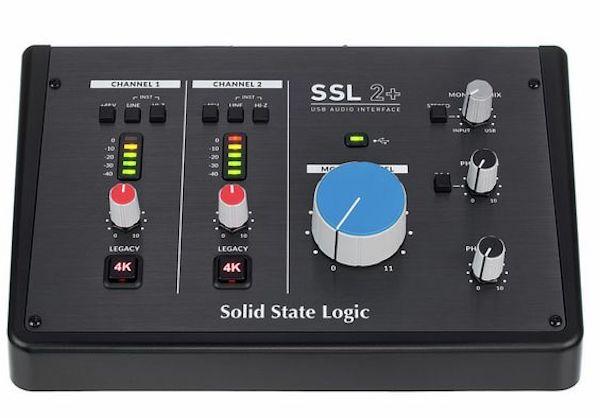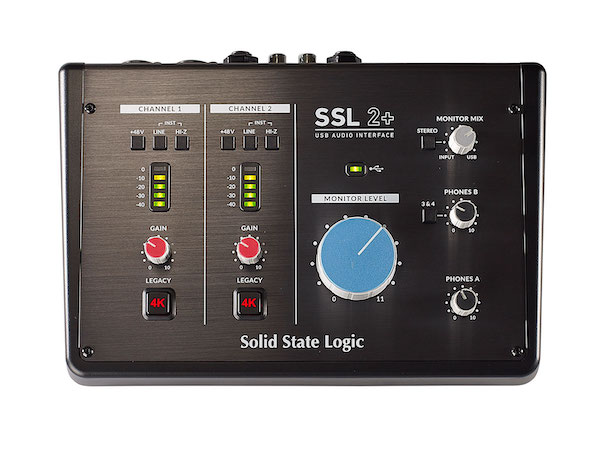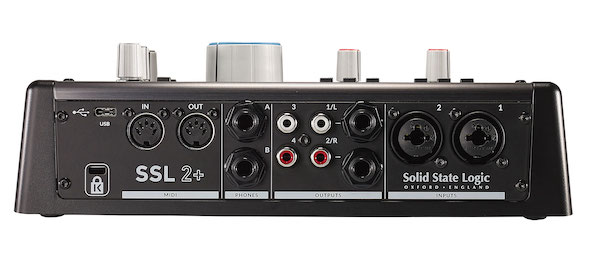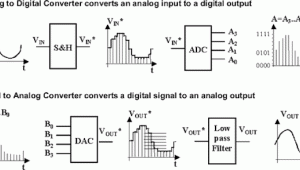literally right after this was published, i opened an older version of pro tools first and found it no longer active. apparently, avid has discontinued pro tools first for new users, though say that they're still giving access to it for those who already have it (i'm testing that right now). apologies for the error.
The SSL 2+: A Home Studio Interface Also Useful For Hi-Fi Enthusiasts

Therefore, hi-fi enthusiasts might find an AD/DA interface, usually marketed for home studio recording and monitoring, quite useful. Over the past decade, these small, usually affordable devices have flooded the market; Focusrite’s sleek, red Scarlett interfaces are probably the most ubiquitous budget ones (I’ve used a Scarlett Solo a couple times and find its sound quite underwhelming), though Universal Audio’s Apollo line has captivated the higher-end home recording market. (The Apollo interfaces notably unlock access to UAD’s plug-ins, and have onboard plug-in processing. UAD also recently unveiled the more competitively priced Volt interfaces, which forgo the Apollos’ plug-in processing. I haven’t tried any UAD products myself.) Solid State Logic, the Oxford, England-based company best known for its mixing desks, to the home recording market arrived late but over the past few years unveiled some smaller (if not necessarily cheap) analog mixers, digital controllers, and the SSL 2 and 2+ interfaces.
Features
Respectively retailing for $270 and $350, the SSL 2 and 2+ both have two XLR and 1/4” inputs with gain adjustment knobs and SSL-designed microphone or instrument preamps, 192kHz/24bit AKM converters, balanced 1/4” monitor outputs, 1/4” headphone outputs, 5-stage level meters for each of the two inputs, monitor mix control, headphone and monitor output volume controls, and Legacy 4K analog enhancement on the inputs. To make recordings less sterile, most home recording interfaces have some sort of one-button analog enhancement; Focusrite interfaces have the “air” button (which adds pleasing but not greatly exciting top end air), while UAD’s Volts 2 and 276 have analog emulations of 610 tube preamps and/or the 1176 compressor. According to SSL, the Legacy 4K effect incorporates the character of their 4000-series consoles, providing a high frequency EQ boost and subtle harmonic distortion. If you have it engaged during recording, you can’t remove it later on though for recording your own material it’s quite beneficial. The 2+ interface adds two unbalanced RCA outputs (the big “Monitor Level” knob controls the volume on those and the 1/4” monitor output), MIDI in/out, and an additional 1/4” headphone output not on the SSL 2. I found the extra features (mainly the RCA outputs) useful, so for $259 I bought a refurbished 2+ from an Amazon seller. All SSL interface purchases include vouchers for SSL Native Vocalstrip 2 and Drumstrip plug-ins, Ableton Live Lite, the Native Instruments Hybrid Keys virtual instrument and Komplete Start production suite, and 1.5 GB of Loopcloud samples. (There used to be a voucher for Avid Pro Tools First and Avid’s Complete Plugin Bundle, though that offer is suspended. Pro Tools First is free with a few basic plug-ins, and I already pay $50 a year for the Avid bundle.)

Setup
The 2+ is USB-C bus-powered, and comes with USB Type C to C and Type C to A cables. It’s class-compliant with Mac OS 10.11 and above, though for Windows you’ll need a driver provided at SSL’s “Get Started” page (where upon registering your interface you also get the software vouchers). Beware that the 2+ can drain your laptop battery, and of course make sure that you select the correct input and output configurations (especially with workstations like Pro Tools). For digitizing vinyl, I used some generic RCA to 1/4” cables connecting my Liberty B2B-1 phono preamp with the SSL; the cables are probably the weak link in my digitization chain, though they’re adequate enough. I also connected the 2+’s RCA outputs with my Hegel H95 integrated amp, and using the Monitor Mix control I could either listen to the record being digitized or anything off my computer (or both, which can get weird—have you ever tried listening simultaneously to the Korean People’s Army Song & Dance Ensemble’s “We Adore You Single-Heartedly” and Sky Ferreira’s Night Time, My Time?).

DAC Quality
Before getting into the 2+ as an A/D converter, it’s worth mentioning its quality as a DAC. Pairing it with lossless files on Apple Music (whose hi-res lossless setting delivers up to 192/24 resolution), the 2+ delivered an honest sound with an airy top end, which I enjoyed through both my Audio-Technica M50x headphones and my full hi-fi system. While the flatter “studio sound” takes a minute to adjust to, I found it detailed and enjoyable, even if audiophile-oriented DACs are tuned to be more pleasing. On headphones, I preferred the SSL’s expansive openness over my excellent but more forward sounding Astell&Kern A&norma SR15, though through speakers I most often prefer a disc on my Arcam CDS50 over both. As with any piece of audio equipment, your preferences will depend on the rest of your system as well as the material you’re listening to, and the 2+’s DAC really reveals recordings for what they truly are. New Order’s Power, Corruption & Lies (Warner Records 96/24 stream) had incredible space, the careful staging on Serge Gainsbourg’s Histoire de Melody Nelson (Mercury 96/24 stream) shone through, the previously mentioned Sky Ferreira album (Capitol Records 96/24 stream) sounded appropriately energetic, and Dinosaur’s “Kiss Me Again” (Warner Music 44.1/16 stream) sounded slightly warm but transparent. However, the 2+ also exposed the sonic mess that is Kanye West’s new Donda 2 (44.16 files) and the fatiguing nature of Yoshinori Sunahara’s new 96/24 remasters of Yukihiro Takahashi’s solo albums. (Side note about the YT remasters: the compression reveals previously hidden details like the vocal reverb on “Drip Dry Eyes,” though you can’t even get through a five-minute song without suffering ear fatigue. I sometimes wish Sunahara would give those compressors a break.) When mixing and mastering in Pro Tools, the 2+ worked spectacularly well with the Audio-Technica headphones, its accurate rendering helping achieve a sound that translated well to other DACs. Hi-fi DACs will sound more engaging, but those on a budget or in search of a desktop DAC could do much worse than this SSL interface. At less than $300 for a perfectly operating refurbished unit or $350 for a brand new one, it’s certainly more flexible than the similarly priced (and also great but very different) Audioquest Dragonfly Cobalt portable DAC, and it certainly sounds a lot better than the $199 Schiit Modius. For my AT cans, I set the SSL’s headphone volume at less than halfway and it’s plenty loud, so it probably drives a decently wide range of headphones.
A/D Conversion Quality
Despite my praise for its DAC, I mainly bought the SSL 2+ for home recording and vinyl digitization. For the previously rare occasion that I’d digitize records, I used an old Zoom R8. It only worked at 44.1 and 48kHz sampling rates, the conversion quality was far from stellar, and it was very noisy. The quiet 2+ works at up to 192kHz, though it takes time and effort to get it properly working. I doubt many people digitize records with Pro Tools, so for my review tests I used Audacity.
For our purposes, the 2+’s main shortcoming is how its two inputs are designed for instruments or microphones, rather than stereo signals from existing sources (despite a “stereo” switch adjacent to the Monitor Mix knob joining two mono inputs as one stereo track). The gain knobs aren’t notched, and on my unit, even matching them to the same markers resulted in some disparity. The 5-stage level meters also have a slight delay in displaying transient information, so to match the levels I opened Audacity, pressed record on a mono record (usually a clean Beatles For Sale 1981 UK mono repress, but not for any particular reason), and using the Audacity meters carefully matched the levels. Is it perfect? No. But is there a noticeable disparity? Unless you have superhuman hearing, probably not. A mono cartridge feeding into a stereo phono preamp would make this calibration tactic more effective, though I did the best with what I have.
Once the channels are calibrated, the transfer is straightforward though make sure you don’t use the Legacy 4K effect on your vinyl transfers; pleasing and exciting as it might sound, in the long run you’ll probably prefer accuracy. The conversion quality, while not necessarily archival in a professional sense, is quite good. The generic RCA to 1/4” cables probably soften my transfers a bit, though transient attack and spatial depth still shine through, and the overall digitization is clear and clean (even if the source material isn’t). Here’s an excerpt from David Bowie’s “Blackout,” taken from an original Sterling-cut UK pressing of ”Heroes” (Greg Calbi at Sterling cut lacquers for both the US and UK original pressings of Bowie’s “Berlin Trilogy”). Despite some minor inner groove distortion, I think this transfer sounds much better than the 2017 remaster on streaming or vinyl, though I’ll leave it at that and let you listen yourself.
Conclusion
For a budget digital audio product, the SSL 2+ is an all-around win, performing its many functions with simplicity and excellence. While it’s not the type of product I’d typically review here, I found its usefulness in listening, monitoring, digitization, and recording more meaningful than any arbitrary product classification, and despite the channel calibration flaws, I’d recommend the 2+ without any hesitation. For the $300 give-or-take price, you get an excellent DAC, a solid headphone amp, RCA and 1/4” outputs, and a very good A/D converter. The more accuracy-focused DAC sound isn’t for everyone, though even as just an ADC it’s worth the cost. It’s also aesthetically pleasing and well-built; I carried it around town in a stuffed backpack and the plastic knobs survived just fine. There are better DACs, better AD/DA interfaces, and better headphone amps, though for those you’ll have to shell out a lot more money often for separate components. As someone who paid for the SSL 2+ myself, I’m well beyond satisfied with its quality and flexibility.
(Malachi Lui is an AnalogPlanet contributing editor, music obsessive, avid record collector, and art enthusiast. Follow him on Twitter and Instagram.)
- Log in or register to post comments


I got Pro Tools First last year when I bought a Focusrite Scarlett 2i2 for digitizing quadraphonic LPs and non-RIAA equalized vinyl (I then process with Stereo Lab Audiophile). Just tried my Pro Tools First and it works. I have version 2021.6 and I had to log into my Avid account when it launched. Maybe you just need to update your Pro Tools First version to the latest, which I noticed is 2021.7 now? I still prefer to use Audacity, though.

pro tools first doesn't work for new users, but i do have it in my avid account (and i've had it for over two years now). mine wasn't working last time i tried it but i'll have to check again, i've been quite slammed recently. i think i prefer audacity for simple vinyl transfers but pro tools first with the avid plug-in subscription is so much better for restoration, mastering, and mixing.

I have a Scarlett 4i4, and I think the conversion is very good. What leads you to think otherwise?

The pro audio market has a set of benchmarks that are less critical of subjective audio SQ, vs. objectivist low-noise measurement specs.
Despite multiple pro audio publications extant, audio quality would be scrutinized to a lower priority compared with performance hi-fi. It's the spirit of innovation (a self-competition per se) and an aggressive marketplace that dictates these different set of priorities in consumer audio, I believe.

Pro audio engineers are responsible for creating the high quality recordings that you play on your "performance hi-fi" gear. There is also a huge market of hobbyists, home recordists, semi-pros, etc., but they would not likely be remastering a 60 year old jazz classic for general distribution or mixing the Atmos track of the Matrix reboot. The bona-fide and highly skilled "pro audio market" is very interested in objective and subjective measures. Many in the semi-pro arena are as well.
The Chinese made SSL interface that Malachi reviewed is not likely to end up in a post production facility at Warner Bros. A custom, British handmade SSL mixing desk with high quality transformers, pots, switches, etc. might. Both fall under the category of "pro audio," so I can understand the confusion. You are correct that specs on lower end gear like the SSL interface are hard to find, but as you move up the chain, things change. For example, from the online publication AudioTechnology.com:
"The [Universal Audio] x8 also boasts impressive total harmonic distortion figures of -113 dB (0.00022% @ 23 dBu) on the line inputs and -119 dB (0.00011% @ -1 dBFS) on the line outputs. Improvements in headroom mean the x6, x8 and x8p boast 129dB DA dynamic range..."
So, I think we can agree that the term "pro audio" is quite broad, but I don't think most people are going to confuse the purpose of a $230 interface with the purpose of a $4,000 device or a $1 million + mixing desk. However, having said that, I can guarantee you that somewhere at some point in time, a hit song was recorded using cheap "pro" audio gear with sketchy specs about which the producer could have cared less; and I can guarantee that an audiophile somewhere at some point in time played that recording on his or her "performance audio" system to show it off, not having the slightest clue that the gear used to make the recording had excessive THD or poor S/N performance. Taylor Swift's $499 Avantone microphone comes to mind. Talent, cleverness, and creativity trump objective specs a lot of the time.
And...you always seem to have that one engineer in the mastering room who can clean up almost any mess a producer can make.


i think i make plenty of sense... my opinion is that the focusrite scarletts sound dull, and i came to that opinion using my ears. but i also understand that the focusrite conversion sounds adequate if you're not aiming for a perfectly pure "natural" recording. how does that not make sense?

Not sure what you mean by "putting a ton of digital effects" on the signal, but I certainly don't find it "dull" for home recording or needle drops.

what i meant is that if you're drowning a vocal in autotune or an instrument in shitloads of reverb, a focusrite sounds fine. but i personally find it meh, not awful but not great. everyone's mileage will vary of course.

I have gone through a number of interfaces from Focusrite 1st and 3rd gen to a Steinberg UR22...all go up to 24/192. The Focusrite "air" is just a gimmick and I don't use and and I have ended up going back to my Original UR22 used in Win 10. It has proven to be more stable for all of my computer audio needs with JRiver and my Sound Forge recording and burning software.
I have not tried this brand, but it sounds like a good bargain and worth the extra money over the Focusrite Scarlett series. My son as used the Scarlett 3rd gen for his twitch gaming with great results. One can't complain for a IO device for a little over $100.
For my needle drops I have used the tape out of my audio gear and run that into one of the portable DR-40's from Tascam and find that much easier as it can do CD quality or 2496 and sounds very good to me.
Thanks for the interesting review.

The Centrance MixerFace is a much more versatile product, and a better value.

All Centrance products are designed and handbuilt in the USA. And when they have their sales you get up to 30 percent off. I got my MixerFace for under 300 clams. I loved it so much I ordered the clip on XLR mics.

I found the simplest solution for me is a Tascam unit that burns direct (About $400 and a one trick pony). Tascam is the pro line of Teac, in case that was not too obvious. While it only requires to be put in the same rack as your gear and connected like any other component and does a decent job using it straight, I found that something goes funny with levels to me, so I burn to a CDRW and load that into the PC for a trip through Audacity to sort things out. Then I can burn to a permanent disc or to a thumb drive or HDD if the playback will be something other than PCM or WAV or what have you, depending on what is needed. So, yes, a little extra work is involved.

Nice overview of a very useful piece of gear. SSL is a legendary Brit company known for its large format mixing desks that have been responsible for some of the biggest records in the universe. There are lots of other products out there that compete favorably, but I'm glad that the hi fi crowd is discovering the semi-pro and pro-level tools. I've been using Universal Audio's UAD gear in my studio for >10 years and it is spectacular. I have two Apollos (x8 and Twin quad) and am equipped with 20 SHARC processors so I can run a lot of their amazing plugins. For hi fi uses, I would think that the Studer or Ampex tape machines would be of supreme interest. And the Studer is available in their new Spark series so you do NOT need UA hardware to run it. It's fully adjustable. You can bias it just like the real thing. You have choices of tape brands and formulas, IPS, etc. You can even add the hiss and hum of the machine if you wish. I use it when I digitize albums so it sounds like a reel to reel recording of vinyl, just like my dad did in the 1970's. Thanks again, and keep doing what you're doing!

I should have also mentioned the Yamaha MG 10 XU 24192 interface as it is an extension of the Steinberg (UR22 Yamaha now owns Steinberg). It offers the advantage 3 mic inputs, plus you can add EQ, Compression, and Effects prior to your audio being digitized and sent to your computer.
It also has line inputs That can be mono or stereo and with a phono preamp you can digitize your vinyl if you wish.

RME's babyface pro fs is an excellent interface with AKM chips for AD and DA conversions. proprietary software offers great flexibility and excellent sound quality for digitizing analog sources. it also has a great headphone amp. I use it for digitizing vinyl for audio restoration purposes which no longer have a master tape. unfortunately newer models have ESS Sabre chips due to AKM factory fire. IMHO try to grab one with AKM.

Michael - I thought you have been using the Lynx Hilo/Pure Vinyl for digitizing LPs? What about comparative virtues of each?

first of all, michael didn't write this SSL review, i did. having heard many of his vinyl transfers with the lynx hilo, as well as some albums known to be recorded with a lynx aurora, i can tell you that the lynx stuff EASILY beats the SSL 2+, but also costs 10 times more.

t’s as much about learning as it is about evolving in mindset or behavior.
Clearance . ph

NBI Clearance is an official certificate which is issued by the NBI that verifies you do not have any criminal record or status in your criminal history. NBI Clearance Online is a fully managed online system implemented by the National Bureau of Investigation (NBI) in the Philippines. Online System makes it easy for you to apply for NBI Clearance, Renew your NBI Clearance Online and NBI Online Registration.

Great overview of the SSL 2 home studio interface! It’s amazing how it bridges the gap for both audio professionals and hi-fi enthusiasts. If you're also interested in learning about net worth and success stories, check out net worth for detailed articles!

Learn how to easily apply for and renew your National Police Clearance Certificate online with NPCS in the Philippines.

To convert CGPA to percentage, multiply your CGPA by 9.5. This number is the percentage. How do you calculate

LMC 8.4 is developed by Hasli and it is a third-party photography application that can be downloaded for free from our website.
If you love taking photos







































